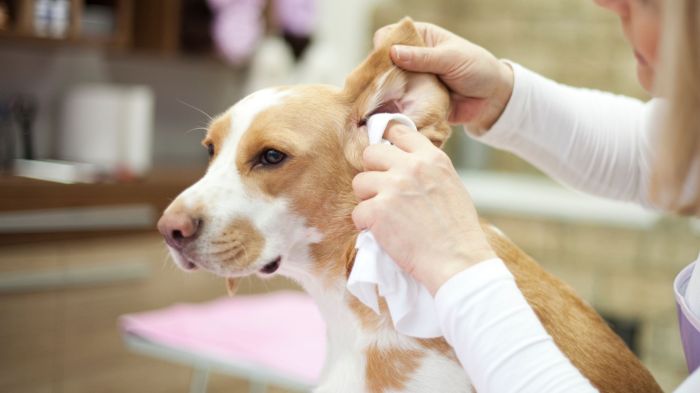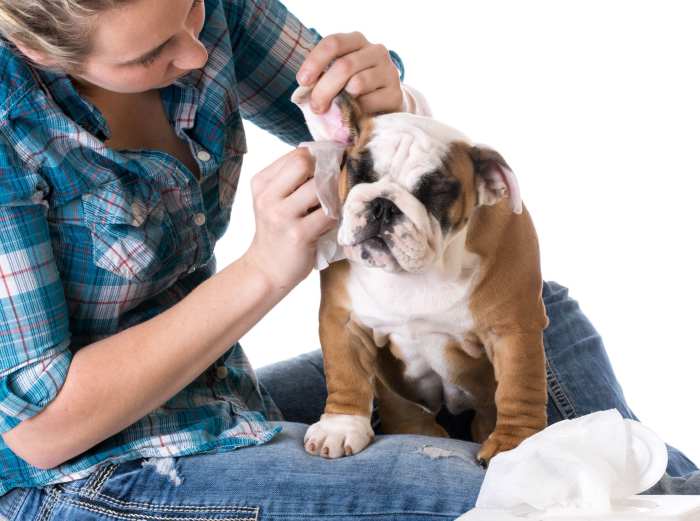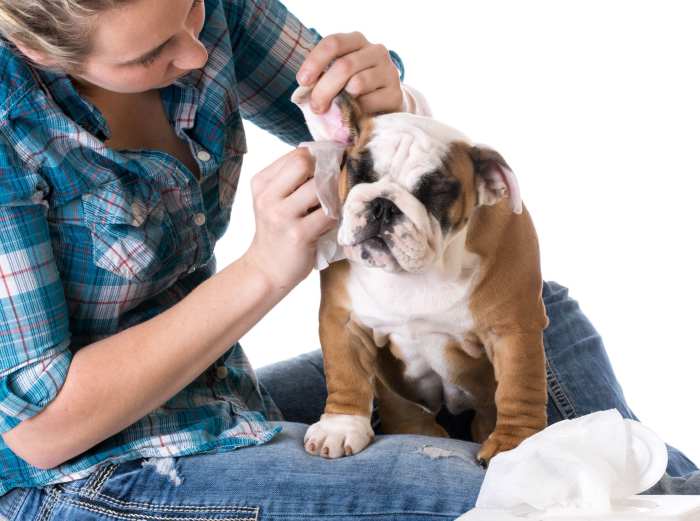DIY ear cleaner for dogs can be a safe and effective way to keep your furry friend’s ears clean and healthy. While commercially available ear cleaners are readily available, many dog owners prefer a more natural approach, using ingredients found in their own kitchens. This guide explores the benefits and limitations of DIY ear cleaners, provides step-by-step instructions for making your own solution, and offers valuable tips for cleaning your dog’s ears safely and effectively.
Maintaining clean ears is crucial for your dog’s overall health and well-being. Ear infections, wax buildup, and allergies can cause discomfort and pain, leading to scratching, head shaking, and even loss of hearing. Understanding the anatomy of a dog’s ear canal and the common problems that can arise is essential for providing proper care. This guide will delve into the different types of ear cleaners available, including both DIY and commercially available options, helping you make informed decisions about the best approach for your furry friend.
Understanding Dog Ear Anatomy

Your dog’s ears are complex structures with several important functions. They are responsible for hearing, balance, and even temperature regulation. Taking care of your dog’s ears is crucial for their overall health and well-being.
Structure of the Dog Ear Canal
The dog ear canal is a narrow, S-shaped tube that extends from the outer ear flap to the eardrum. It is lined with skin that contains hair follicles, glands, and a special type of wax called cerumen. The ear canal is responsible for channeling sound waves to the eardrum, which vibrates and transmits these sounds to the inner ear. The cerumen in the ear canal helps to protect the ear from foreign objects and bacteria.
Common Ear Problems in Dogs
- Ear Infections: Ear infections are one of the most common ear problems in dogs. They can be caused by bacteria, yeast, or mites. Symptoms of an ear infection include head shaking, scratching at the ears, ear odor, and redness or swelling inside the ear.
- Wax Buildup: Excessive wax buildup in the ear canal can also lead to problems. This buildup can trap moisture and create an environment where bacteria and yeast can thrive.
- Allergies: Allergies are another common cause of ear problems in dogs. Food allergies, environmental allergies, and even allergies to certain types of ear cleaners can all trigger ear infections.
Types of Ear Cleaners
There are many different types of ear cleaners available for dogs. Some are specifically designed to clean the ear canal, while others are designed to treat ear infections. It is important to choose an ear cleaner that is safe and effective for your dog.
- Commercial Ear Cleaners: Many commercially available ear cleaners are formulated to dissolve wax and debris, remove moisture, and soothe irritated ears. These cleaners are often available in different formulations, depending on the specific needs of your dog.
- Home Remedies: Some people choose to use home remedies to clean their dog’s ears. These remedies may include apple cider vinegar, hydrogen peroxide, or olive oil. However, it is important to note that these remedies can be harmful to dogs if not used properly.
DIY Ear Cleaner Recipes
Creating a homemade ear cleaner for your dog can be a cost-effective and natural way to keep their ears healthy. However, it’s important to understand the potential benefits and limitations before attempting this.
Ingredients and Safety Considerations, Diy ear cleaner for dogs
Choosing the right ingredients is crucial for a safe and effective DIY ear cleaner. Here are some tips:
- Apple Cider Vinegar: Diluted apple cider vinegar helps balance the pH of the ear canal, reducing yeast and bacterial growth.
- Witch Hazel: Witch hazel has astringent properties that can help dry out excess moisture in the ear canal, which can contribute to infections.
- Hydrogen Peroxide: While it can be used to clean ears, hydrogen peroxide can be irritating and should be used sparingly.
- Glycerin: Glycerin helps to soften earwax and make it easier to remove.
- Essential Oils: Some essential oils, such as tea tree oil, have antimicrobial properties. However, they should be used with extreme caution in dogs, as they can be toxic.
It’s essential to use high-quality ingredients and ensure they are safe for dogs. Always dilute ingredients and test a small amount on a non-sensitive area of your dog’s skin before applying it to their ears.
Homemade Ear Cleaner Recipe
Here’s a basic recipe for a DIY ear cleaner:
- Mix equal parts apple cider vinegar and water in a clean bottle.
- Add a few drops of glycerin to the mixture.
- Shake the bottle well to combine the ingredients.
This solution can be used to clean your dog’s ears once a week or as needed.
Benefits and Limitations
Using a DIY ear cleaner can offer several benefits:
- Cost-effective: It can be cheaper than commercially available ear cleaners.
- Natural: It avoids harsh chemicals often found in store-bought cleaners.
- Control over ingredients: You can choose ingredients that are specifically suited to your dog’s needs.
However, there are also limitations:
- Potential for irritation: Some ingredients, even when diluted, can irritate sensitive ears.
- Lack of professional formulation: DIY cleaners may not be as effective as commercially available solutions.
- Risk of contamination: If not prepared and stored properly, DIY cleaners can become contaminated.
Always consult with your veterinarian before using any DIY ear cleaner, especially if your dog has a history of ear problems.
Signs of Ear Problems in Dogs

It’s important to be aware of the common signs of ear problems in dogs, as early detection and treatment can help prevent further complications. Recognizing these symptoms can help you seek veterinary care promptly, ensuring your furry friend receives the appropriate treatment.
Ear Infections in Dogs
Ear infections, also known as otitis externa, are a common problem in dogs. They can be caused by various factors, including allergies, bacteria, yeast, and parasites. Recognizing the signs of an ear infection is crucial for timely treatment.
- Head shaking: This is a common sign of ear discomfort. Your dog may shake their head violently, trying to dislodge something from their ear.
- Scratching at the ears: Dogs with ear problems often scratch their ears excessively, sometimes even causing redness or irritation.
- Ear discharge: Ear discharge can vary in color and consistency, ranging from clear to yellow, brown, or even bloody. It can also be foul-smelling.
- Ear odor: A strong, unpleasant odor coming from the ear can be a sign of an infection.
- Redness and swelling: The skin around the ear flap may become red and swollen.
- Pain: Dogs with ear infections may show signs of pain, such as yelping or flinching when their ears are touched.
Seeking Veterinary Care for Ear Problems
If you notice any of the signs of an ear infection in your dog, it’s essential to consult a veterinarian. A veterinarian can examine your dog’s ears, diagnose the cause of the problem, and recommend the appropriate treatment.
Preventing Ear Problems in Dogs
Preventing ear problems in dogs can help avoid discomfort and potential complications. Here are some tips to keep your dog’s ears healthy:
- Regular ear cleaning: Regular ear cleaning can help remove dirt, debris, and excess wax, reducing the risk of infections.
- Dry the ears after bathing: Make sure to dry your dog’s ears thoroughly after bathing, as moisture can create a breeding ground for bacteria and yeast.
- Avoid excessive ear plucking: Excessive ear plucking can irritate the ear canal and increase the risk of infection.
- Treat underlying allergies: Allergies can contribute to ear infections. If your dog has allergies, treating them can help prevent ear problems.
- Regular veterinary checkups: Regular veterinary checkups can help identify any ear problems early on, when they are easier to treat.
Dog Ear Cleaning Frequency: Diy Ear Cleaner For Dogs
Cleaning your dog’s ears is essential for their health and well-being. However, over-cleaning can be just as harmful as neglecting their hygiene. Finding the right balance is key.
The frequency of ear cleaning depends on various factors, including your dog’s breed, age, and ear condition. Some dogs require more frequent cleaning than others.
Factors Affecting Ear Cleaning Frequency
The following factors influence how often you should clean your dog’s ears:
- Breed: Certain breeds are more prone to ear infections due to their ear shape and structure. Floppy-eared dogs, like Cocker Spaniels and Basset Hounds, are more susceptible to ear infections. These breeds often have narrow ear canals that trap moisture and debris, creating a breeding ground for bacteria and yeast.
- Age: Puppies and senior dogs may need more frequent ear cleaning. Puppies are more susceptible to ear infections due to their developing immune systems, while senior dogs may have weakened immune systems or underlying health conditions that increase their risk of ear infections.
- Ear Condition: Dogs with existing ear infections or allergies require more frequent ear cleaning to manage their condition. Ear infections can be caused by various factors, including bacteria, yeast, mites, and allergies.
Signs of Ear Problems in Dogs
It’s important to be aware of the signs of ear problems in dogs so you can address them promptly. If you notice any of the following symptoms, consult your veterinarian:
- Excessive head shaking
- Scratching at the ears
- Redness or swelling inside the ears
- Discharge from the ears (brown, yellow, or bloody)
- A foul odor coming from the ears
- Pain when the ears are touched
- Loss of balance or tilting of the head
Determining If Your Dog’s Ears Need Cleaning
Here are some tips to determine if your dog’s ears need cleaning:
- Visual Inspection: Examine your dog’s ears regularly for any signs of redness, swelling, discharge, or debris. If you notice anything unusual, it’s a good idea to clean their ears.
- Smell Test: If you notice a foul odor coming from your dog’s ears, it’s a sign that they need cleaning. This odor can indicate an ear infection or buildup of wax and debris.
- Dog’s Behavior: If your dog is excessively shaking their head, scratching their ears, or tilting their head, it could be a sign of ear problems. These behaviors are often associated with discomfort or pain in the ears.
Potential Risks of Over-Cleaning Dog Ears
While regular ear cleaning is essential, over-cleaning can also be harmful. Over-cleaning can irritate the delicate skin inside the ear canal, leading to dryness, inflammation, and even infections. Here are some potential risks of over-cleaning:
- Dryness and Irritation: Over-cleaning can strip the ear canal of its natural oils, leading to dryness and irritation. This can make your dog’s ears more susceptible to infections.
- Inflammation: Excessive cleaning can irritate the delicate skin inside the ear canal, causing inflammation and redness. This can be uncomfortable for your dog and may make their ears more prone to infections.
- Ear Infections: Over-cleaning can disrupt the natural balance of bacteria and yeast in the ear canal, increasing the risk of ear infections.
Keeping your dog’s ears clean and healthy is an essential part of their overall well-being. By understanding the anatomy of their ears, recognizing signs of ear problems, and using appropriate cleaning methods, you can ensure your furry friend enjoys a comfortable and happy life. Remember to consult your veterinarian if you have any concerns about your dog’s ear health. With a little care and attention, you can help your dog maintain healthy ears and enjoy a long and happy life.
Keeping your furry friend’s ears clean is crucial for their health, and while store-bought ear cleaners are readily available, you can also try making your own. If you’re feeling crafty, you could even try creating a DIY Moana outfit for your dog, inspired by the beloved Disney movie. diy moana outfit Just remember, when it comes to your dog’s ears, always consult with your veterinarian before using any homemade solutions.

